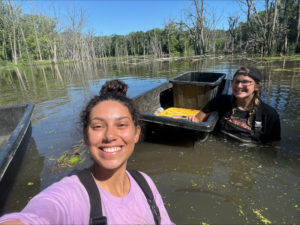What information is collected when you find a turtle?
This week we are focussing on a common question most of the WEL team has been asked by friends, family, and the general public. The general procedures for on-site sampling as well as what we record on our Health Assessment data sheet will be discussed below.

The WEL Health Assessment data sheet has 3 main parts:
Part 1: Sample and Turtle Identification
Using our health assessment data sheet as a checklist, we perform physical exams and record the turtle’s information. The sample information includes turtle identification, capture data, and demographics. Turtle identification includes Lab ID’s; Name; Notch Codes; Frequency; Pit Tag; Mom ID and varies per county and per turtle. Capture data includes the County; Field site location; Capture type; and Outcome of the turtle. Next we record the demographics of the turtle, this includes the Sex; Age Class; Weight; Shell Measurements; and BCI (automatically calculated when the weight and shell measurements are entered).
Part 2: Physical Exam
The physical exam portion is where we note any abnormalities present. If we are unable to examine any category, we mark ‘NE’ (not examined), if no abnormalities are noted, we mark ‘WNL’ (within normal limits). Any lesions that look new/still healing are marked as ‘Active’. Starting off with the carapace, which is the top portion of the shell, we look for pitting, erosions, predator injuries, fractures, and discoloration. Predator injuries are subjective but may include teeth marks. Mild flaking and erosions of the shell can be normal, but are marked in addition to the WNL box if there are no other abnormalities. The same can be done for the plastron, which is the bottom part of the shell. The mentation of the turtle is also recorded and evaluated based on the behavior of the turtle during the exam. All 5 senses are evaluated and have designated sections for the eyes, nares, oral cavity, tympanum, and integument in our data sheet. For females we check if eggs are present by feeling in between the plastron and the integument on the caudal portion of the turtle. The cloaca is also evaluated especially for females during nesting season where it swells. Finally we take photos of the carapace, plastron, and the face of each turtle.
Part 3: Sample Collection
Sample collection begins by collecting blood from the subcarapacial sinus, 0.2-0.3 ml of whole blood is placed in a lithium heparin microtainer (CBC). 0.2 ml whole blood is placed in another lithium heparin microtainer and is used as a backup for pathogen work. Up to 2.4 ml whole blood in lithium heparin plasma separator, and 1 drop is placed in a 300 μL RNA later container. Four swabs will be used to collect DNA, two of the swabs will be COS (Cloacal Oral Swabs) and two will be COSS (Cloacal Oral Shell Swab). All four swabs will be placed in the mouth and then gently into the cloaca, the two COSS swabs will then be rubbed vigorously around the carapace and plastron.
After all of the on-site sampling is complete, the team will return to the lab station for further tests and DNA extraction procedures. All of which will be discussed in a later post.
